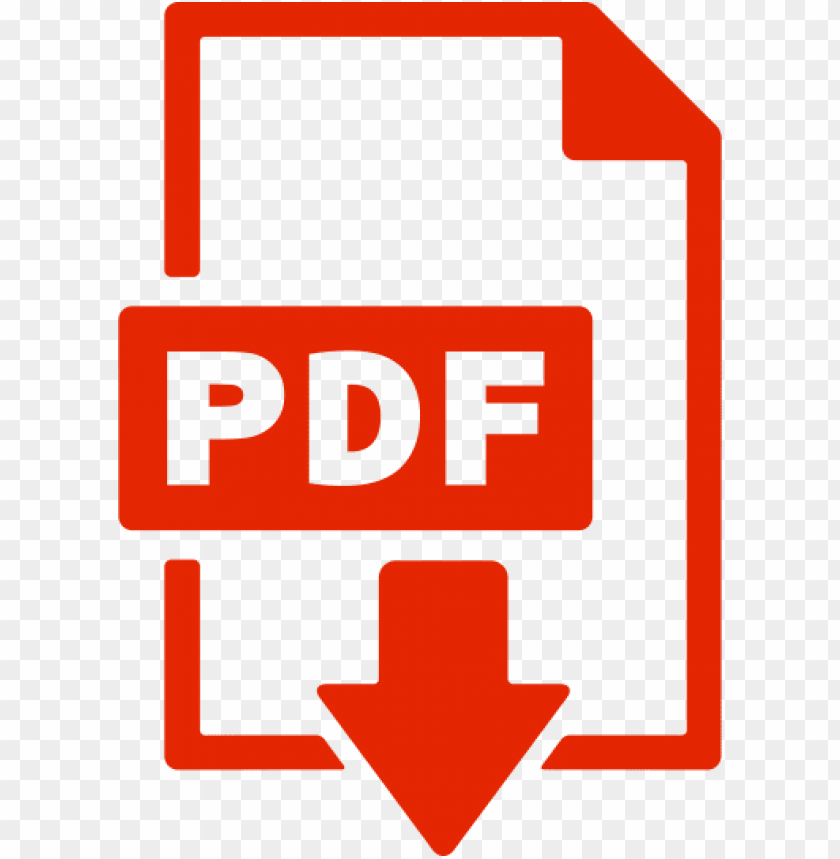June/July 2024
General Announcement
- Call for IAG proposals for the IUGG Support Program of Scientific Meetings in 2025
- Discover the Importance of Terrestrial Reference Frames
- Re-establishment of Absolute Gravity Database (AGrav) at BGI and BKG
Meeting Announcement
- Joint Webinar on Advancing Geodesy and Navigation with Quantum Sensors
Meetings Calendar
IAG Sponsored Meetings
- 20th Geodynamics and Earth Tides Symposium (G-ETS 2024)
- Gravity, Geoid and Height Systems 2024
- GGOS Topical Meeting on the Atmosphere
- GGOS Days 2024
- SIRGAS 2024 Symposium
- 6th Joint International Symposium on Deformation Monitoring (JISDM)
- IAG Scientific Assembly 2025
Geodesy Related Meetings
- Joint Webinar on Advancing Geodesy and Navigation with Quantum Sensors
- 32th IAU General Assembly
- 2024 European Polar Science Week conference
- ESA 9th International Colloquium on Scientific and Fundamental Aspects of GNSS 2024
- 2025 Glacial Isostatic Adjustment workshop: Advancing Models and Observational Constraints
Reports
- Chinese Annual Geodetic General Assembly (CAGGA) 2024 held in Xi'an, China
Obituary
- Oscar Colombo (1942-2024)
General Announcements
Call for IAG proposals for the IUGG Support Program of Scientific Meetings in 2025
We would like to draw your attention to opportunities of support/sponsorship from the IUGG for selected scientific meetings (e.g., workshops, advanced schools, symposia) planned in 2025.
The call for proposals is open, refer to: https://iugg.org/meetings/guidlines-for-meetings-support/
If you wish to propose a meeting via IAG, please contact the IAG Secretary General – IAG-Office(at)bkg.bund.de − and submit your request until 30th of September 2024. There will be an IAG-internal reviewing process with a decision by end of October.
Proposed scientific meetings for the IUGG Support Program must:
- Have a well-defined, scientifically relevant and actual topic in the fields of geodesy/geophysics;
- Have scientific merit and a balanced scope w.r.t. IUGG associations i.e. preference will be given to multi- and trans-disciplinary meetings;
- be internationally oriented;
- be inclusive in view of countries/regions, gender and career stage of the participants.
Your request to IAG must specify all entries listed below:
- Name of meeting, venue and dates
- Primary sponsors and other known co-sponsors
- Name and address of the Chair of the Local Organizing Committee
- Meeting website
- Scientific objective and scope of the meeting
- Estimated number of participants, abstracts, and sessions
- Level of support requested (in US$) and explanation of how the money will be used
- Additional information as appropriate
Thank you in advance for your interest and kind cooperation!
IAG Bureau
Discover the Importance of Terrestrial Reference Frames
The Global Geodetic Observing System (GGOS) of the International Association of Geodesy (IAG) has released an enlightening 2 minute video showcasing the critical role of geodetic terrestrial reference frames in our world. This short film illustrates how these reference frames are essential to both science and society, enabling countless innovative, location-based applications. Every time you use your smartphone for navigation, you're relying on a precise, internationally recognized terrestrial reference frame made possible by the science of Geodesy.
This video, available on the GGOS YouTube channel, is in English with subtitles in more than 16 languages, making it accessible to a global audience. Watch the short version here: https://youtu.be/zfqq-0d2txk
This short video supplements the very successful 10-minute long film version available since September 2023. The long version, narrated by native speakers in 12 languages, has been watched more than 40,000 times and provides a more comprehensive exploration of the importance of terrestrial reference frames. You can watch the long version here.
Both videos were produced by GGOS within its Coordinating Office at the Federal Office of Metrology and Surveying (BEV) in Vienna, Austria. In addition, the short version was produced in collaboration with the United Nations Global Geodetic Center of Excellence (UN-GGCE) to better engage a general audience interested in understanding the benefits of geodesy.
Martin Sehnal
Director of GGOS Coordinating Office
Re-establishment of Absolute Gravity Database (AGrav) at BGI and BKG
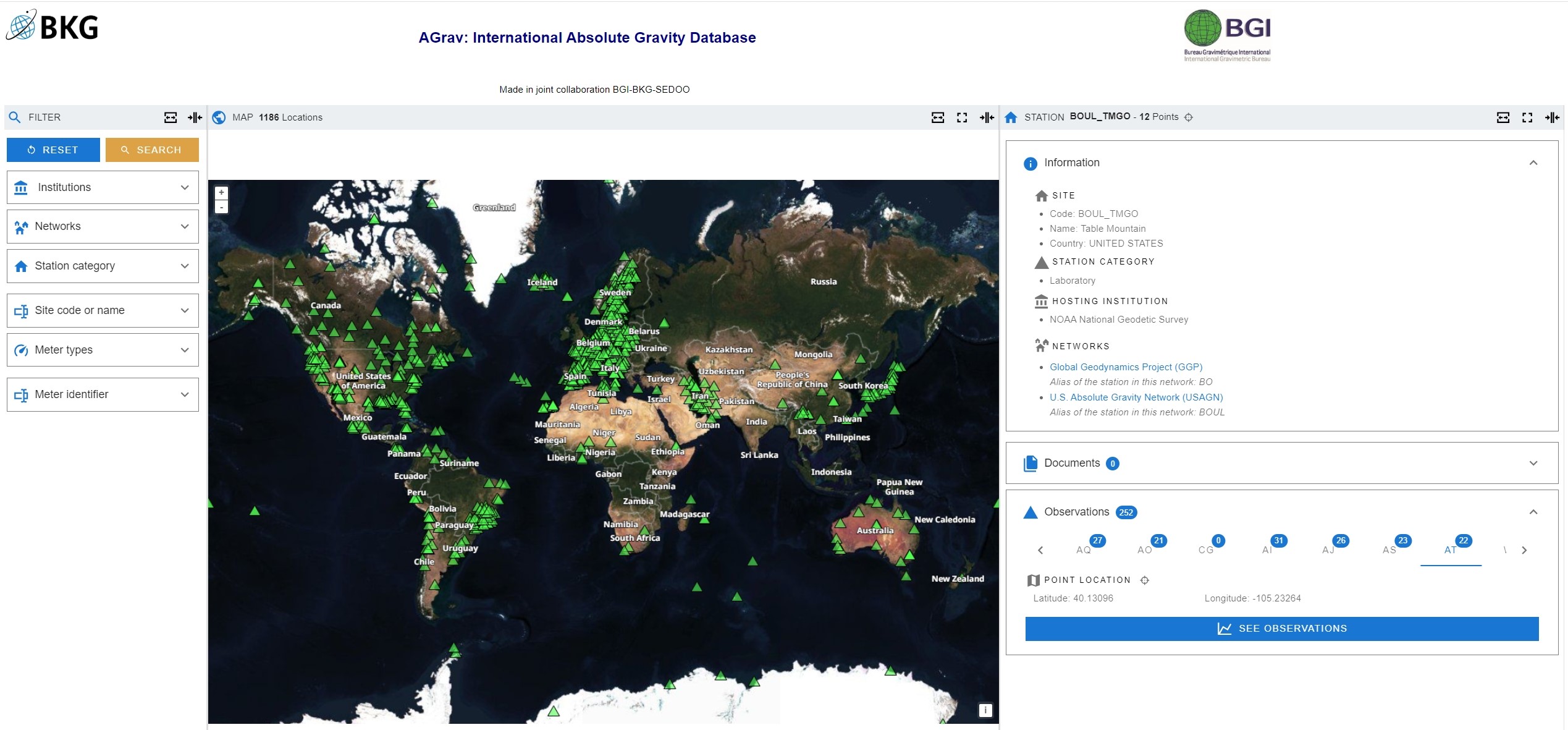
Dear colleagues,
After the AGrav database was offline for more than 2 years, we are happy to inform you that it is now successfully re-established at BGI jointly with BKG, with the technical support of Observatoire Midi-Pyrénées (SEDOO service). The whole dataset existing at AGrav until Feb 2022 is now accessible with a modern Web interface via the following links at BGI and BKG.
- https://bgi.obs-mip.fr/data-products/gravity-databases/absolute-gravity-data/
- https://agrav.bkg.bund.de/
The interface has a new structure that allows data to be selected and navigated through different criteria: institution, network or station categories, site code/name or instruments. The current contents replicate the status of the AGrav database with its last update end of January 2022. Further updates will be possible soon again with new observations provided by contributors by uploading acquisition and processing results in the main exchange format (”g”-software project files).
Access to the database is generally possible without registration. The accuracy of gravity values and other details is given to anonymous users within the limits set by the contributing institutions. DOI’s will be also attributed to instruments and networks.
The database is considered an important part of the upcoming International Terrestrial Gravity Reference Frame (ITGRF), the main task of IAG Joint Working Group JWG 2.1.1 for the current term.
We hope the relaunch of AGrav will be a success and allows for a great collaboration in the future.
Best regards,
Sylvain Bonvalot (BGI), Hartmut Wziontek (BKG) and François André (OMP/SEDOO).
Meeting Announcement
Joint Webinar on Advancing Geodesy and Navigation with Quantum Sensors
Joint webinar on "Advancing Geodesy and Navigation with Quantum Sensors" will take place on Monday, 29 July 2024, at 9:00 - 10:30 CEST. It is co-organised by the IAG Project QuGe: Novel Sensors and Quantum Technology for Geodesy and the IAG Joint Study Group 4.1.1: Evaluating the Potential of Next Generation Quantum Sensors for Positioning, Navigation and Timing (PNT) as well as by the International Federation of Surveyors Working Group (WG) 5.7: Emerging Technologies for PNT.
It is meant for a wide audience from experts to interested colleagues. Presentations will be given by colleagues from academia and industry.
Topics will include:
- Introduction to quantum sensors and their principles
- Quantum-enhanced metrology for geodesy
- Performance of quantum sensors in navigation systems
- Case studies and recent advancements
- Future directions and challenges in integrating quantum technologies
More information and a link for registration can be found here:
Allison Kealy and Jürgen Müller
Meetings Calendar
IAG Sponsored Meetings
- 20th Geodynamics and Earth Tides Symposium (G-ETS 2024), August 25-30, 2024, Strasbourg, France
URL: https://g-ets2024.sciencesconf.org/ - Gravity, Geoid and Height Systems 2024, September 4-6, 2024, Thessaloniki, Greece
URL: https://www.gghs2024.com/ - GGOS Topical Meeting on the Atmosphere, October 7-9, 2024, Potsdam, Germany
URL: https://ggos.org/event/ggos-topical-meeting-atmosphere/ - GGOS Days 2024, October 10-11, 2024, Potsdam, Germany
URL: https://ggos.org/event/ggos-days-fa-meeting-2024/ - SIRGAS 2024 Symposium, November 18-21, 2024, Bogotá, Colombia
URL: https://sirgas.ipgh.org/simposio-2024/en/home-2/ - 6th Joint International Symposium on Deformation Monitoring (JISDM), April 7-9, 2025, Karlsruhe, Germany
URL: https://jisdm2025.gik.kit.edu/ - IAG Scientific Assembly 2025, September 1 – 5, 2025, Rimini, Italy
URL: https://eventi.unibo.it/iag2025
Geodesy Related Meetings
- Joint Webinar on Advancing Geodesy and Navigation with Quantum Sensors, July 29, Online
URL: https://events.teams.microsoft.com/event/0acc400e-c47d-4374-b166-081598227366@df7f7579-3e9c-4a7e-b844-420280f53859 - 32th IAU General Assembly, August 6-15, 2024, Cape Town, South Africa
URL: https://astronomy2024.org/ - 2024 European Polar Science Week conference, September 3 – 6, 2024, Copenhagen, Denmark
URL: https://www.europeanpolarboard.org/news-events/events/event/events/2024-european-polar-science-week-conference/ - ESA 9th International Colloquium on Scientific and Fundamental Aspects of GNSS 2024, September 25-27, 2024, Wroclaw, Poland
URL: https://atpi.eventsair.com/9th-gnss-science-colloquium/ - 2025 Glacial Isostatic Adjustment workshop: Advancing Models and Observational Constraints, 2025 Glacial Isostatic Adjustment workshop: Advancing Models and Observational Constraints, June 2-6, 2025, Sydney, British Columbia, Canada
URL: https://polenet.org/2025-gia-workshop/
Report
Chinese Annual Geodetic General Assembly (CAGGA) 2024 held in Xi'an, China
The Chinese Annual Geodetic General Assembly 2024 was successfully held on May 17-19, 2024 in Xi'an, China. This year’s assembly was jointly organized by the China National Committee for IAG (CNC-IAG) and the Geodesy and Navigation Committee of the Chinese Society for Geodesy.
More than 1800 participants from universities, institutes and administration departments all over the country gathered in Xi'an to attend this conference full of scientific inspirations. Academicians of Chinese Academy of Science, Prof. Yuanxi Yang, Prof. Heping Sun and Prof. Sidao Ni, Academicians of Chinese Academy of Engineering, Prof. Jiancheng Li attended the assembly. Prof. Yuanxi Yang, Prof. Jiancheng Li, Prof. Sidao Ni, and Prof. Zhenhong Li were invited to deliver keynote speeches.
The general assembly is composed of the high-level forum, the outstanding youth forum and the following 7 parallel sessions: (1) Precise positioning and reference frame; (2) Gravity field and vertical datum; (3) Navigation, positioning and location based service; (4) Geodetic monitoring and geodynamics; (5) GNSS monitoring and assessment; (6) Marine geodesy; (7) Image Geodesy Technology and Application. More than 200 oral presentations and 300 posters were presented, which reflected the latest development and progress in the fields of GNSS navigation and positioning, gravity field and geoid modeling, geodetic data processing and Earth d
ynamics in the past year.
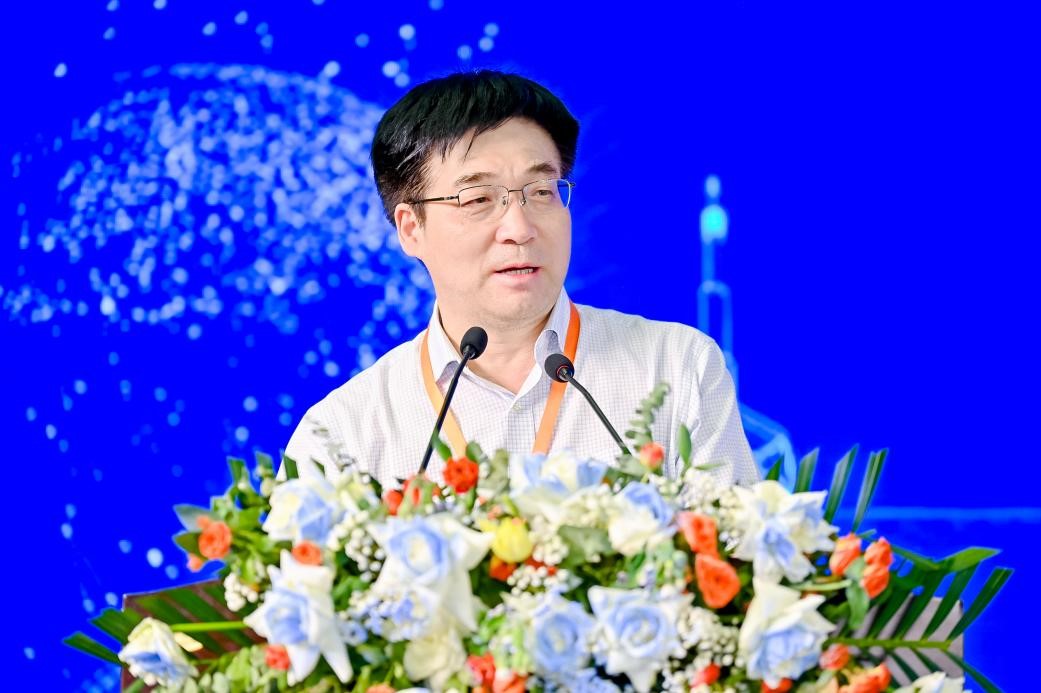
Welcome speech by CNC-IAG president, Prof. Yamin Dang
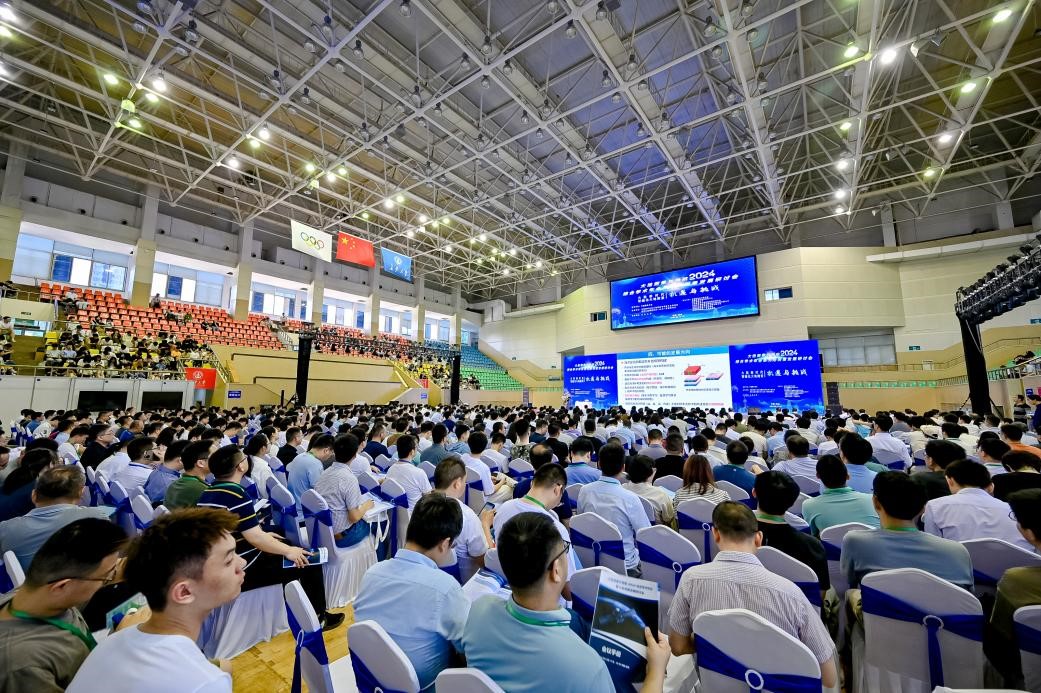
Keynote presentation
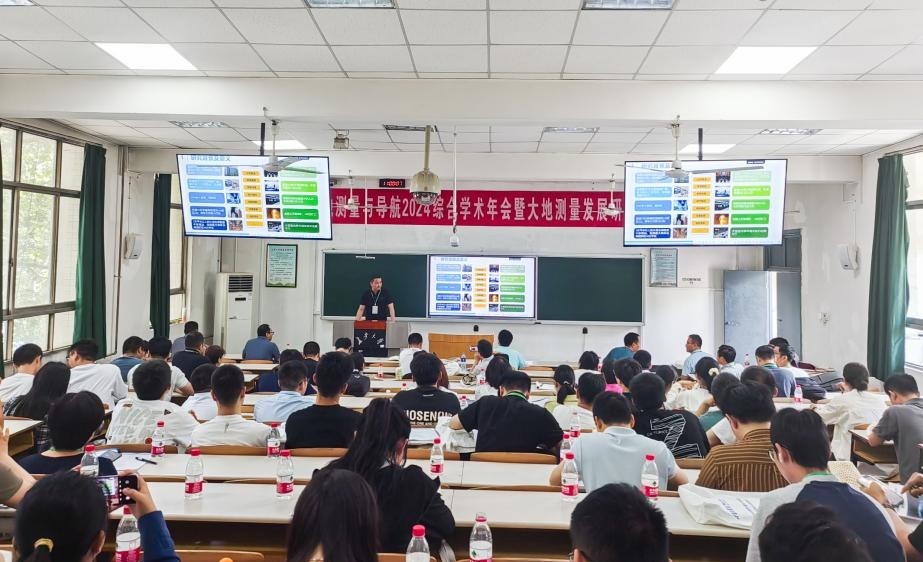
Oral session
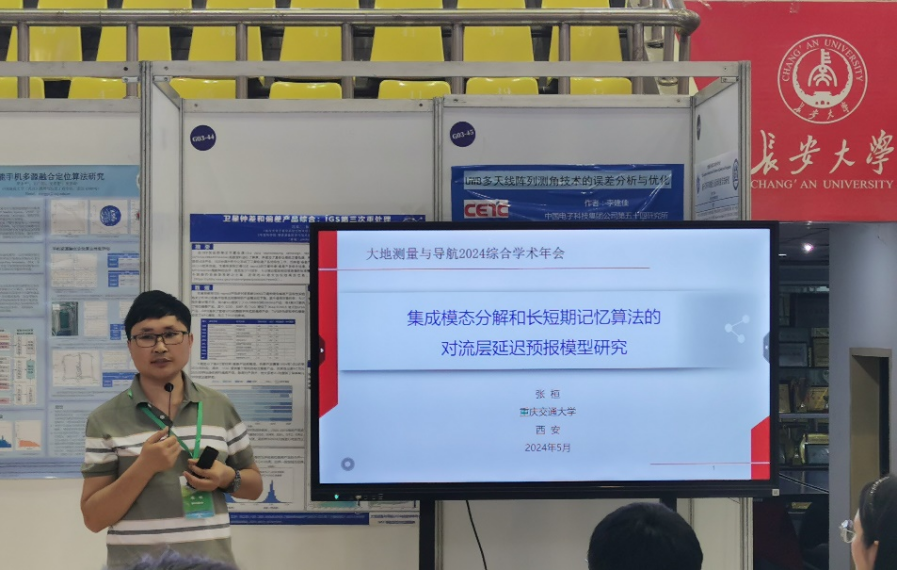
Poster session
Tao Jiang
Obituary
Oscar Colombo (1942–2024)

IAG fellow Oscar L. Colombo passed away on June 1, 2024, just shy of his 82nd birthday. He was the senior geodesist in the Geodesy and Geophysics Laboratory at the NASA Goddard Space Flight Center, where he had been since 1983. Oscar also spent extended periods as a visiting scientist at institutes in Japan, Australia and Europe. Over his long career he made important contributions in satellite altimetry, gravity determination, and the use of Global Positioning System (GPS).
Oscar Colombo was born in the city of Pergamino, in the province of Buenos Aires, Argentina on July 16, 1942. He received his education in Argentina through his undergraduate degree at the Universidad Nacional de la Plata in 1967. Oscar then moved to Australia and earned a PhD in Electrical Engineering in 1977 from the University of New South Wales (UNSW) in Sydney. His thesis was entitled “On the control of discrete-time systems with constrained input and state variables”. Oscar's geodetic career began soon thereafter when he began working with the prominent geodesist, Ron Mather, also at UNSW. Oscar worked there until Mather's sudden death in September 1978. Mather's geodesy team had had strong collaborations with the Department of Geodetic Science at The Ohio State University (Columbus, Ohio) in the area of satellite ocean altimetry, and after Mather's death Oscar moved to OSU at the invitation of Professor Richard Rapp. While at OSU Oscar completed several publications in the well-known Report series of the Department of Geodetic Science. Rapp's geodesy group was also working with scientists at NASA Goddard Space Flight Center where Oscar would eventually find his home base. In 1982 Oscar left Ohio State for a fellowship at the Delft University of Technology (Delft, The Netherlands). This was an extremely productive period during which Oscar produced important reports on gravity determination, including a long report published in 1983 by the Netherlands Geodetic Commission on “The Global Mapping of Gravity with Two Satellites.” This was a blueprint for GRACE-like gravity missions. Furthermore, the report showed how the required computations could be accomplished within the limits of the computers of that time.
In 1983 Oscar came to NASA Goddard where he was employed under various contracts and university grants. In his first years at Goddard, Oscar continued work on satellite gravimetry and gradiometry, but he also worked extensively on preparations for the TOPEX/Poseidon satellite altimeter mission. Those efforts included chairing an IAG Special Study Group (1987-1991) on precise orbit determination. The resulting advances in orbit determination eventually contributed importantly to the then-unprecedented precision of the TOPEX/Poseidon sea-surface topography measurements, the backbone of a now three-decade time series of precise sea levels. At about the same time, Oscar began focusing heavily on new civilian geodetic applications of the Global Positioning System (GPS). He eventually concentrated on kinematic GPS, which became an important mainstay of his work for many years. His expertise in GPS, and eventually in the more general Global Navigation Satellite Systems (GNSS), was widely appreciated and led to many collaborations in Japan, Australia, and Europe. For example, Oscar worked with Japanese colleagues to combine kinematic GPS with acoustic observations to determine the position of seafloor stations off the coast of Japan. Other applications of GNSS included his work on ionospheric mapping. Eventually Oscar returned to the topic of precise GNSS-based orbit determination, which led at Goddard to improvements to the ICESat, ICESat-2 and GEDI laser-altimeter missions. Late in his career he became interested in using anomalous ionosphere perturbations measured by GNSS to detect possible tsunami signatures. One of his final publications was a NASA Technical Memorandum describing a tsunami early-warning system based on a global constellation of Cubesats that use GNSS.
Oscar was devoted to geodesy and he lived very simply. He drove the same small car that he bought in the 1980s until the time of his death. Oscar was famously not a morning person. He did most of his work at night. He enjoyed dining out with friends and discussing music, literature, and politics. His many friends and colleagues will miss his conversations, his wit, his company, and, of course, his expertise in geodesy.
D. Rowlands, C. Carabajal, R. Ray
NASA Goddard Space Flight Center
The IAG Newsletter is under the editorial responsibility of the Communication and Outreach Branch (COB) of the IAG. It is an open forum and contributors are welcome to send material (preferably in electronic form) to the IAG COB (newsletter@iag-aig.org). These contributions should complement information sent by IAG officials or by IAG symposia organizers (reports and announcements). The IAG Newsletter is published monthly. It is available in different formats from the IAG new internet site: http://www.iag-aig.org.
Each IAG Newsletter includes several of the following topics:
- news from the Bureau Members
- general information
- reports of IAG symposia
- reports by commissions, special commissions or study groups
- symposia announcements
- book reviews
- fast bibliography
| DOCUMENTS |
| IAG_Newsletter_June-July_2024.pdf |
